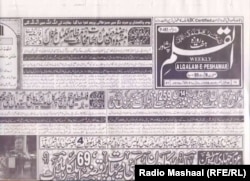Men crowd around a newsstand outside a mosque in northwestern Pakistan, buying newspapers and stuffing bank notes into a transparent plastic tub.
An Urdu-language inscription on the box says, "The poor, destitute victims of natural disasters and the heirs of martyrs await your help."
This is no ordinary stall, however, and the newspaper hawked by the three volunteers on a recent sweltering afternoon is no ordinary broadsheet.
They are members of Jammat-ud Dawa, which the United Nations says is an alias for Lashkar-e Taiba. Jammat-ud Dawa and its leaders have been on a UN sanctions list of known supporters of the Taliban and Al-Qaeda, and Lashkar-e Taiba is considered one of the biggest militant organizations in South Asia. It is blamed for the 2008 attack in India that killed nearly 170 people when gunmen stormed landmarks in the country's financial capital, Mumbai.
Jarar, the Urdu-language newspaper sold in a back alley of Peshawar, promotes something with which residents of this northwestern Pakistani city are very familiar.
Its news stories, opinion pieces, and editorial mostly glorify jihad or a violent struggle against India, Israel, and other non-Muslim states. It also often lauds the Afghan Taliban for fighting against the Western-backed government in Kabul.
Peshawar, a city of an estimated 4 million residents, first served as a bastion for Afghan jihadists fighting against the Soviet occupation of neighboring Afghanistan in the 1980s. But two decades later it became one of the most dangerous urban areas in the world when a new generation of jihadists turned their guns on Pakistan.
Since 2004, 60,000 Pakistan civilians, soldiers, and militants have died in militant attacks and military operations against them. Khyber Pakhtunkhwa Province and the adjacent Federally Administered Tribal Areas are the main theater for most of the fighting. Provincial capital Peshawar has borne the brunt of jihadist violence.
Pakistani authorities, however, are doing little to rein in the rhetoric of Jarar and scores of similar newspapers, magazines, and websites that advocate jihad and focus on the exploits of an array of jihadists ranging from Lashkar-e Taiba to the Afghan Taliban and even Islamic State militants bent on expanding their Islamic empire from the areas they control in Iraq and Syria to the entire greater Middle East.
Just a few kilometers away from the narrow lanes of Peshawar's center, evidence of the jihadist media's success in radicalizing youth abounds.
Muhammad Ismail, a twentysomething student at the sprawling Peshawar University, has been an avid reader of Jarar and other publications for six years. His favorite now is a weekly called Al-Qalam, whose fiery writings are molding his worldview.
"Jihad is a form of worship," he told Radio Mashaal. "I really like the writings of Saadi in Al-Qalam. One section in this magazine updates you on the fighting in Afghanistan, Kashmir, and Palestine every week."
Local observers say Al-Qalam is published by Jaish-e Muhammad or the Army of Muhammad. This banned militant group was founded by Maulana Masood Azhar, a firebrand cleric who was released from an Indian prison in 1999 in exchange for passengers of a hijacked Indian airliner. Pakistani counterterrorism experts say Azhar, who lives in hiding in Pakistan's eastern Punjab Province, uses Saadi as a pen name.
Azhar is considered to helm two other popular jihadist publications. Daily Islam and weekly Zarb-e Momin are dedicated to glorifying Taliban violence in neighboring Afghanistan. Both are published in Urdu, a language that very few Afghans speak or understand.
Faizullah Jan, a journalism professor at Peshawar University, has researched Pakistan's jihadist media for years. He says the jihadist publications seek to foster a particular worldview.
"These publications want their audience to know how they view the developments in Pakistan and abroad," he told Radio Mashaal. "Secondly, they are very successful at enticing the youth toward their cause. These publications also help jihadist groups fund-raising effort."
He says that apart from glorifying violent struggles, some jihadist publications are now bent on portraying themselves as mainstream press.
"They are now attempting to target all sections of society, including women and children. Many have websites and can be easily purchased and subscribed to," Jan said.
Ahsanullah, a newspaper seller in Peshawar, says jihadist publications are aggressively increasing their audience.
"These publications are not finding many subscribers in Peshawar's affluent neighborhoods, but their readers are multiplying in the rural suburbs," he told Radio Mashaal.
After the Taliban massacred 150 schoolchildren and teachers in Peshawar last December, Islamabad announced a comprehensive national counterterrorism plan earlier this year.
Key provisions of the plan promised to take "strict action against the literature, newspapers, and magazines promoting hatred, decapitation, extremism, sectarianism, and intolerance." It also promised to "ban the glorification of terrorists and terrorist organizations through print and electronic media."
But nearly eight months later, Islamabad seems to have done very little to address these sources of an accelerating radicalization in the country.








